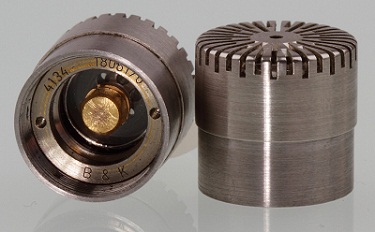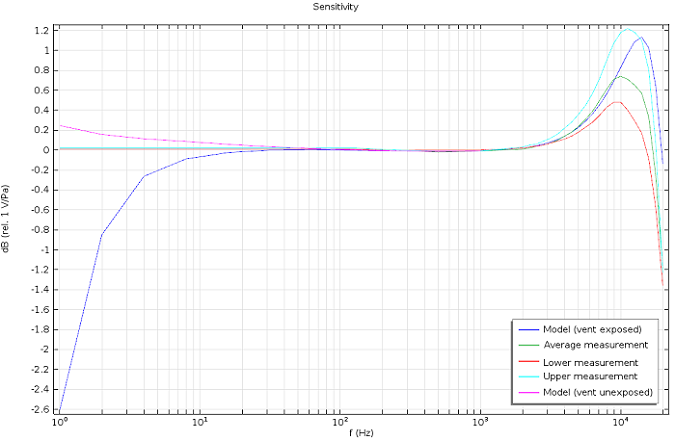
When performing an analysis on small-scale audio equipment, such as hearing aids, cell phones, and microphones, the obvious physical phenomenon that’s analyzed is pressure acoustics. However, there are other physics interactions that significantly affect these small devices, including electromechanical interactions and viscothermal losses. Most notably, thermoacoustics (the detailed modeling of acoustics including thermal conduction and viscous losses) is an often overlooked effect that can alter the results of a model. These effects are important in all devices with small length scales. The Brüel and Kjær 4134 Condenser Microphone model is a perfect example of these multiphysics interactions, with four different physics interfaces (Thermoacoustics, Membrane, Electrostatics, and Moving Mesh) used to model the sensitivity level, membrane deformation, pressure, velocity, and electric field of a condenser microphone.
Brüel & Kjær, a Leading Producer of Condenser Microphone Analysis
Brüel and Kjær is a leading supplier of sound and vibration measurement solutions for various industries around the globe. Part of their vision is to deliver “innovative technical solutions [that] create sustainable value” for their customers. Brüel & Kjær prides itself on being the industry standard in the area of measurement-grade microphones, providing accurate and detailed acoustic measurements. Maintaining the output quality of their products includes the use of COMSOL Multiphysics to refine and improve their microphone analysis devices. Recently, they created a model of a 4134 condenser microphone to simulate the results of different parameters.

Picture of the Brüel and Kjær 4134 microphone including the protection grid mounted on the housing. Image courtesy of Brüel and Kjær Sound & Vibration Measurement A/S.
Thermoacoustics, a True Multiphysics Simulation
Many modeling studies have been performed on the Brüel and Kjær 4134 microphone that did not include all the physical effects acting on the microphone. In the COMSOL Multiphysics simulation however, four different physics interfaces were used to provide a more accurate model. The Thermoacoustics interface solves the acoustics in a detailed way by including thermal conduction and viscous losses (this is also known as viscothermal or thermoviscous acoustics, and it solves the linearized continuity, Navier-Stokes, and energy equations); the Electrostatics interface measures the change in the electric field and electrostatic forces across the microphone; the Membrane interface sets up a pre-tensioned physics for the diaphragm inside the casing; and the Moving Mesh interface models the deformation of the diaphragm membrane when pre-polarizing the microphone.
The microphone is essentially an electromechanical transducer that transforms the movements of the diaphragm caused by sound pressure into an electric signal measured in volts. The relationship between the (acoustic) input pressure field P_{in} and the voltage output V_{out} is the sensitivity level L, defined as:
The sensitivity plot (shown below) compares two differing model results with the lower, upper, and average measurement values. As you can see, the results of the model, which have no free tuning parameters, compare favorably with the results from the experimental measurements. The sensitivity of the microphone is an important specification when deciding between varying microphone models. More results, including the membrane deformation, velocity, sound pressure level, temperature, and electric potential, can be found in the model documentation, along with complete instructions on setting up and running the model.

Microphone sensitivity curve from the model with exposed (blue) and unexposed (pink) vent. Three measurement curves are also added (green, red, and cyan) to illustrate the variability in the microphone sensitivity.
An Upcoming Webinar on the Simulation of Acoustics Devices
Thermal conduction and viscous losses significantly affect acoustic devices, and should be included in all simulations with small-scale geometries. Due to the complicated nature of this physics coupling, all the necessary equations are automatically coupled and solved simultaneously by the software to make it easier for the user. To learn more about thermoacoustics and how to model small acoustics devices, attend the upcoming webinar on “Acoustics Simulation in Microphones, Mobile Devices and Hearing Aids“. The Brüel and Kjær 4134 Condenser Microphone model will be shown to display the different physics described in this post and to demonstrate how they can be included in your own simulations.




Comments (0)